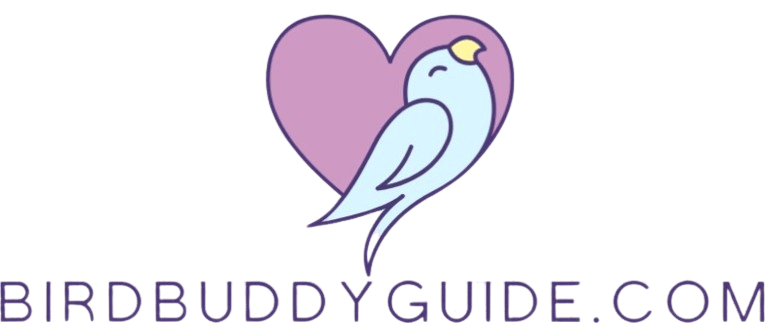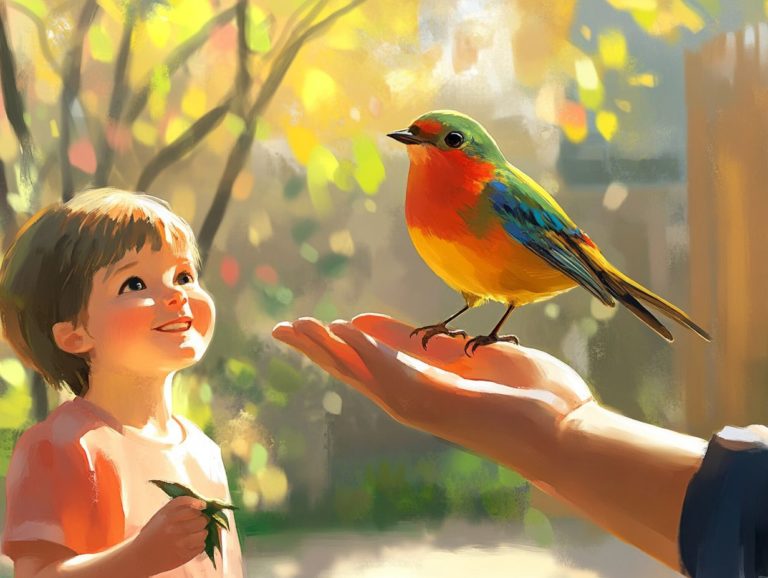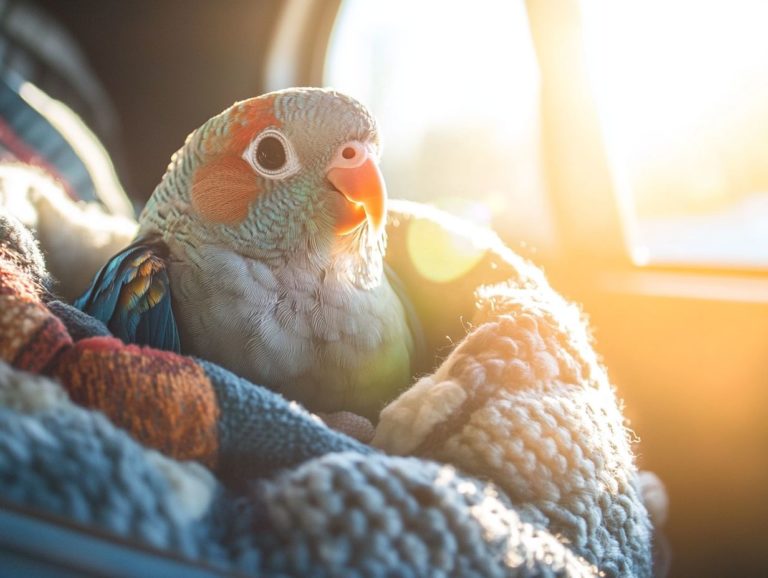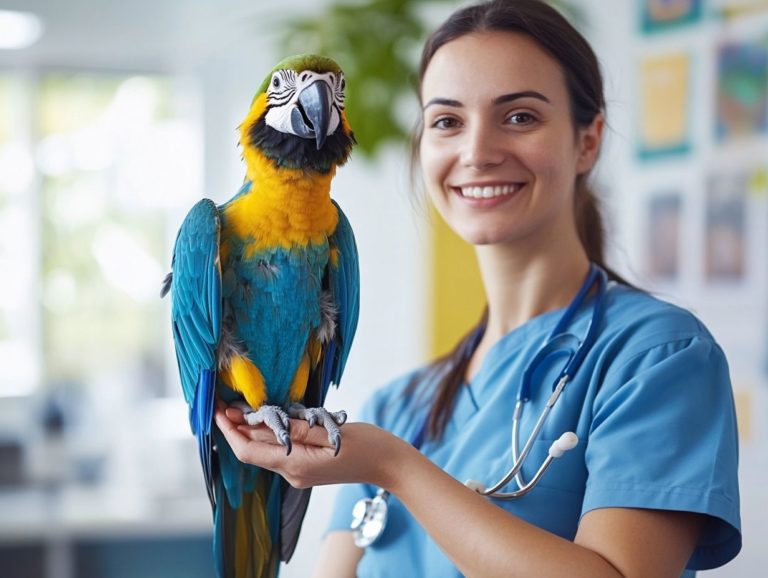How to Safely Handle a Wild Bird?
Wild birds are truly captivating beings that enrich our ecosystems and bring endless joy to those who take the time to appreciate them. When you encounter a wild bird be it in your backyard or on a serene nature walk it prompts important questions about how to interact with these creatures safely and respectfully.
Get ready to explore the fascinating world of wild birds and their unique behaviors! You ll learn essential safety precautions for handling these delicate animals and the steps necessary for capturing and releasing them responsibly. You ll also discover what to do if you come across an injured bird, ensuring you re equipped with the knowledge to provide proper first aid and transport.
We will also share tips on creating a bird-friendly environment that helps prevent injuries. Join us as you navigate the delicate balance between enjoying the beauty of our wild avian friends and protecting their well-being.
Contents
- Key Takeaways:
- Understanding Wild Birds
- Safety Precautions When Handling Wild Birds
- Steps for Safely Handling a Wild Bird
- What to Do if You Find an Injured Wild Bird
- Tips for Preventing Injuries to Wild Birds
- Frequently Asked Questions
- 1. How should I prepare to handle a wild bird?
- 2. How should I approach a wild bird in order to handle it safely?
- 3. What should I do if I find a sick or injured wild bird?
- 4. Can I touch a wild bird’s nest or eggs?
- 5. How long can I safely handle a wild bird?
- 6. Are there any potential risks to handling a wild bird?
Key Takeaways:
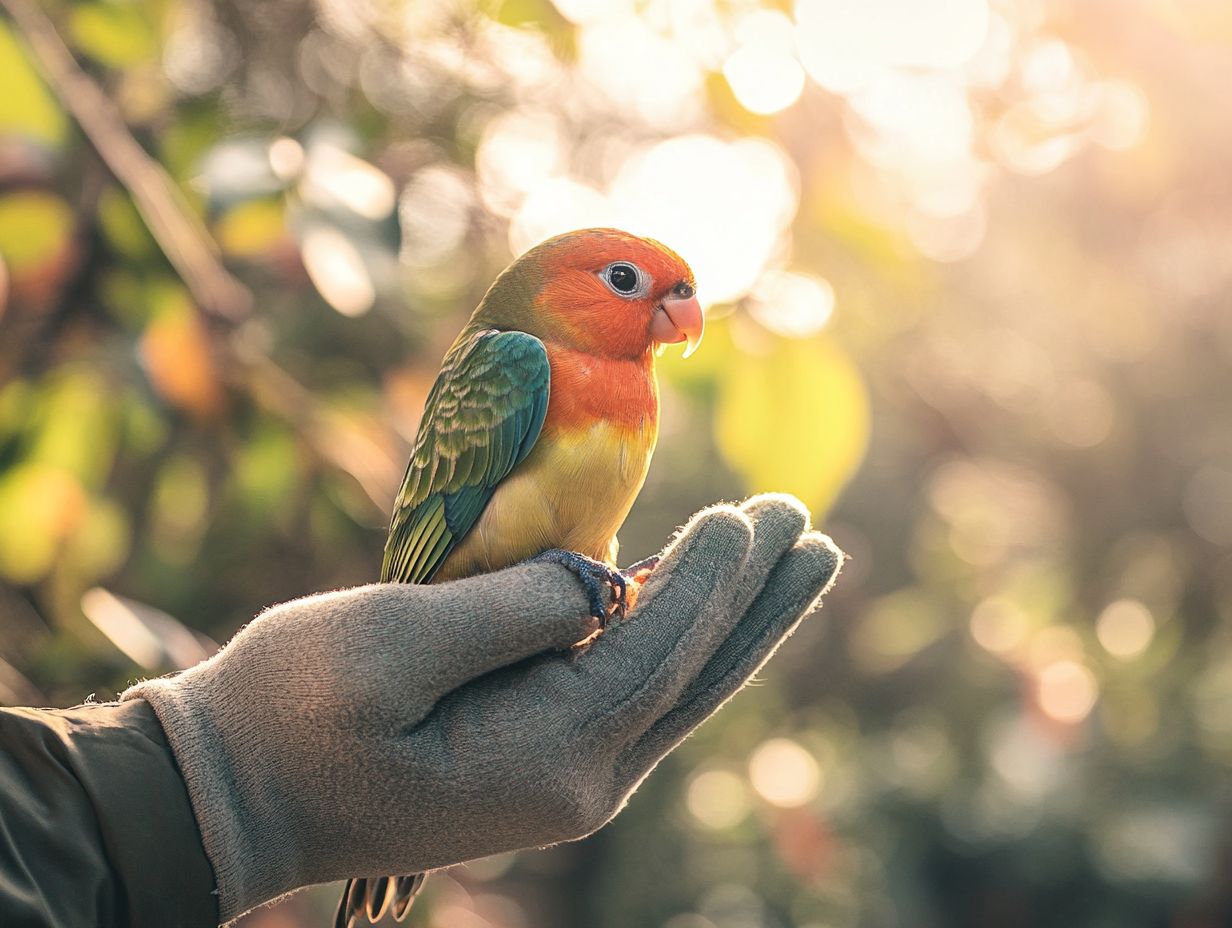
- Protect yourself and the bird by wearing protective gear and avoiding direct contact with the bird’s beak and claws.
- Approach, capture, and release the bird carefully to avoid causing further harm to the bird or yourself.
- If you find an injured wild bird, provide proper first aid and transport it to a licensed wildlife rehabilitator for further care and treatment.
Understanding Wild Birds
Understanding wild birds is essential for you to truly appreciate their vital role in the ecosystem and to recognize the distinct behaviors displayed by different species, like the majestic American White Pelicans and the agile Western Grebes.
This knowledge gives you the power to interact respectfully with these feathered residents in areas such as Big Bear Valley, a popular destination for wildlife enthusiasts.
Places like the Chirp Nature Center offer wonderful opportunities to observe and learn about these avian wonders, enhancing your experience and connection to nature.
Types of Wild Birds and Their Behaviors
You ll discover a myriad of wild bird species, each showcasing unique behaviors essential for their survival. These behaviors include their feeding and nesting habits.
Take hummingbirds, for example. Their incredible methods of feeding on flower nectar involve specialized bills that extract energy-rich liquids. This is an absolute necessity for their high metabolism.
On the flip side, owls mostly hunt at night, which allows them to thrive in the shadows.
Nesting behaviors vary widely among species. The elaborate weaver bird constructs intricate nests to woo potential mates, while others, like the migratory Arctic tern, embark on remarkable journeys to find the most suitable breeding grounds.
Migration patterns hold equal importance. Many species, such as swans and geese, follow seasonal routes that align with their food sources and habitat conditions, ensuring their resilience and continuity in an ever-changing environment.
Safety Precautions When Handling Wild Birds
When handling wild birds, prioritizing safety precautions is crucial to minimize stress for both the bird and yourself. Act quickly if you find an injured bird. Your prompt actions can make a difference! Seeking guidance from a licensed wildlife rehabilitator can offer invaluable assistance in these situations.
By understanding the correct approach, you can significantly reduce the risk of potential injuries and ensure the bird’s well-being throughout the handling process.
Join us in protecting these incredible creatures by applying what you learn today!
Protecting Yourself and the Bird
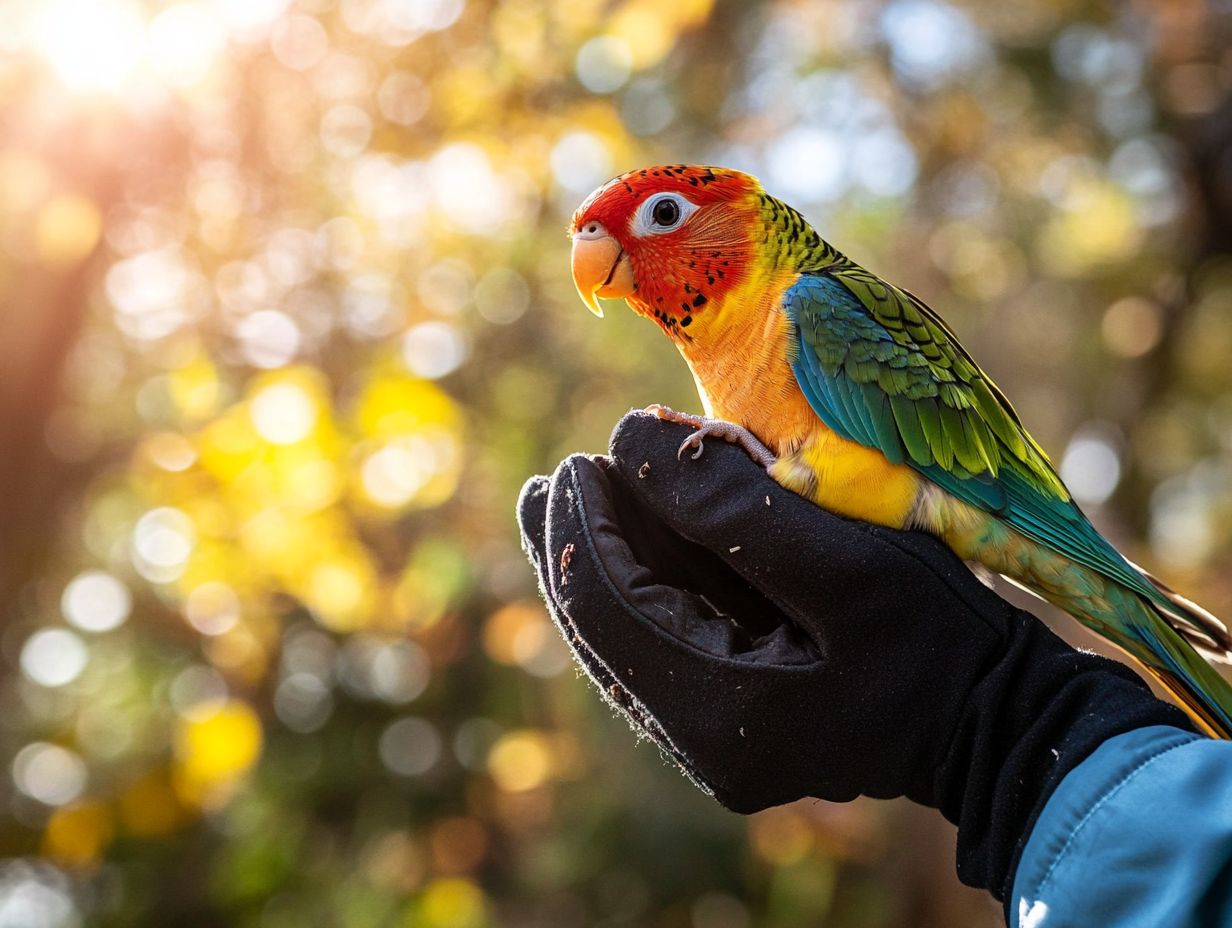
Protecting yourself and the wild bird during handling is crucial. Both can experience stress and potential injury without proper precautions.
By utilizing the right techniques, you can safeguard both parties and ensure a more positive interaction.
Before you engage with wild birds, it s essential to wear gloves. This simple step can prevent injury from sharp beaks or claws and reduce the risk of transmitting any diseases.
Equipping yourself with proper tools, such as bird nets or soft carriers, can significantly smooth out the process and enhance safety.
Pay close attention to the bird for signs of stress like rapid breathing, fluffed feathers, or attempts to escape because these indicators suggest that the bird feels threatened.
To foster a calm atmosphere, consider dimming the lights and minimizing loud noises. Using a gentle voice and approaching slowly and steadily will further ease tension, making the experience less daunting for both you and the bird.
Steps for Safely Handling a Wild Bird
Safely handling a wild bird requires you to follow a series of carefully followed steps, including the right approach, capture, transport, and ultimately release back into its natural habitat.
Each stage of this process is essential for ensuring the bird’s health and minimizing stress during its recovery.
By taking the time to navigate these steps thoughtfully, you contribute to the well-being of the bird and enhance the success of its return to the wild.
Approaching, Capturing, and Releasing
The key to approaching, capturing, and releasing a wild bird effectively lies in your ability to create a calm environment that enables a gentle, stress-free interaction.
By employing the right techniques, you enhance the bird’s comfort and pave the way for a successful return to its natural habitat.
Understanding the specific behaviors of the species you re working with is crucial, as is ensuring that the surroundings remain quiet and unobtrusive.
Speaking in a soft voice and making slow movements will work wonders in reducing anxiety levels.
Using tools like humane nets designed to safely capture birds minimizes the risk of injury.
Once you have secured the bird, placing it in a safe, dark, and well-ventilated container helps to further calm it during transport.
Timing is everything. Releasing the bird at dusk or dawn, when it is naturally more active, can significantly increase its chances of successfully reorienting itself in familiar surroundings, allowing it to seamlessly resume its role within the ecosystem.
What to Do if You Find an Injured Wild Bird
When you encounter an injured wild bird, your first step should be to administer appropriate first aid and then transport it to a licensed wildlife rehabilitator capable of providing specialized care.
Act quickly! Your prompt action can save the bird’s life and help it return to the wild.
Proper First Aid and Transporting Techniques
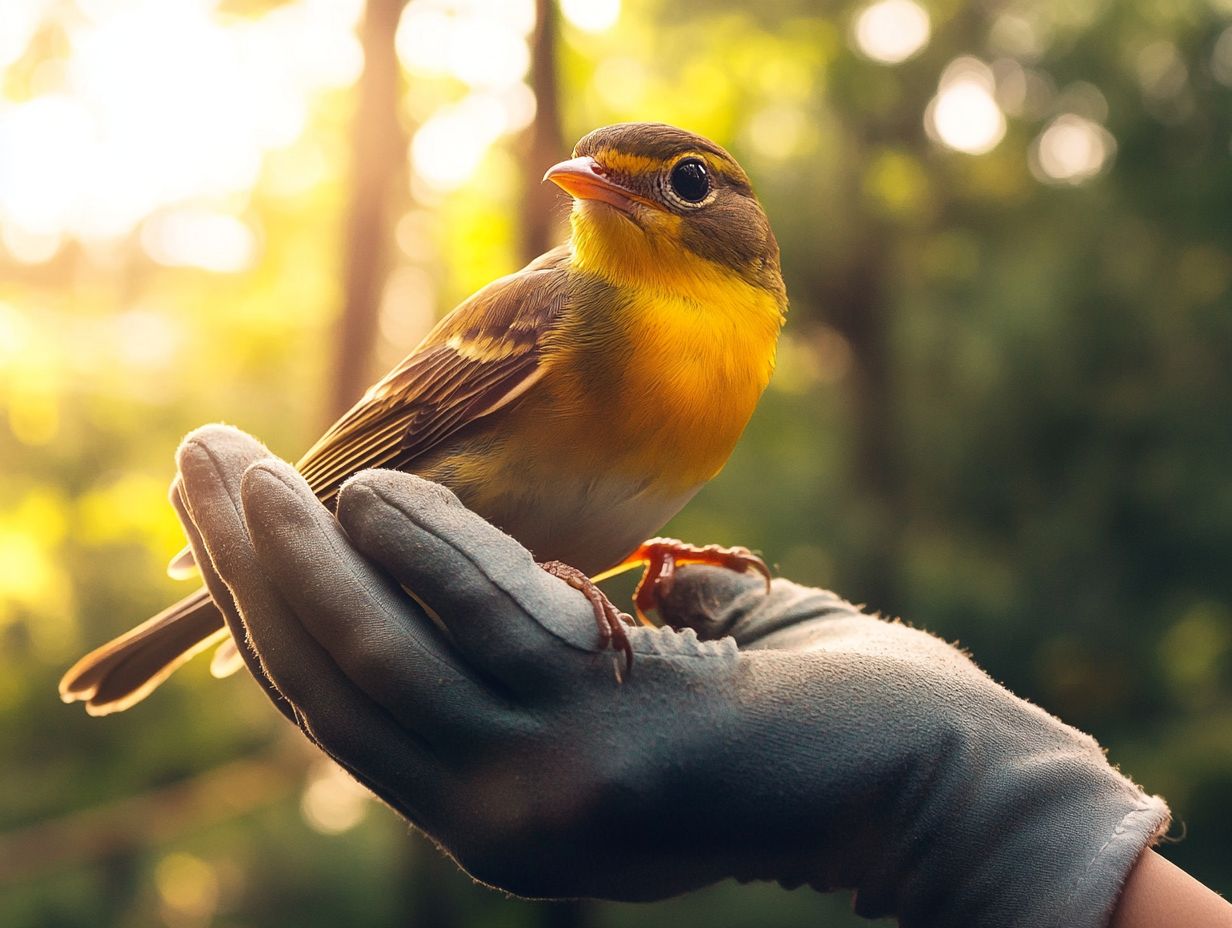
Administering proper first aid and employing effective transportation techniques are crucial when you encounter an injured bird.
This ensures its well-being and minimizes stress during its recovery journey.
Keeping the bird calm and secure can greatly enhance its chances of survival.
Start by gently approaching the bird to avoid startling it further. If possible, wear gloves to protect both yourself and the animal.
Assess the extent of its injuries, paying attention to any visible wounds or signs of distress.
If the bird shows signs of shock, providing warmth is essential. Wrapping it in a soft, breathable cloth can help stabilize its condition.
Once secured, place the bird in a well-ventilated box lined with a soft towel to cushion it during transport.
Throughout this process, remember that a quiet, dim environment can significantly help maintain the bird’s composure, allowing it to feel more secure as it embarks on its journey to rehabilitation.
Tips for Preventing Injuries to Wild Birds
Preventing injuries to wild birds requires your commitment to creating a bird-friendly environment. This helps reduce risks and enhances their well-being. By doing so, you not only reduce stress for the birds but also for those who care for them.
Engaging in simple yet impactful actions can greatly contribute to fostering a healthier habitat for these delightful feathered companions.
Creating a Bird-Friendly Environment
Creating a bird-friendly environment involves making thoughtful choices that enhance the safety and well-being of wild birds. Consider installing feeders, providing nesting materials, and minimizing hazards like windows and reflective surfaces. By taking these steps, you can support the local avian population and promote the variety of birds and plants.
One practical approach is to select feeders designed for various bird species. This ensures they have access to nutritious food year-round. Incorporating native plants into your landscaping offers natural food sources and establishes essential nesting sites.
Introducing safe nesting boxes and avoiding harmful pesticides can greatly improve the survival rate of young birds. Applying bird-safe window decals helps prevent collisions, while keeping the area around feeders clean reduces the spread of disease among bird populations.
These small changes can make a huge difference for our feathered friends!
Frequently Asked Questions
1. How should I prepare to handle a wild bird?
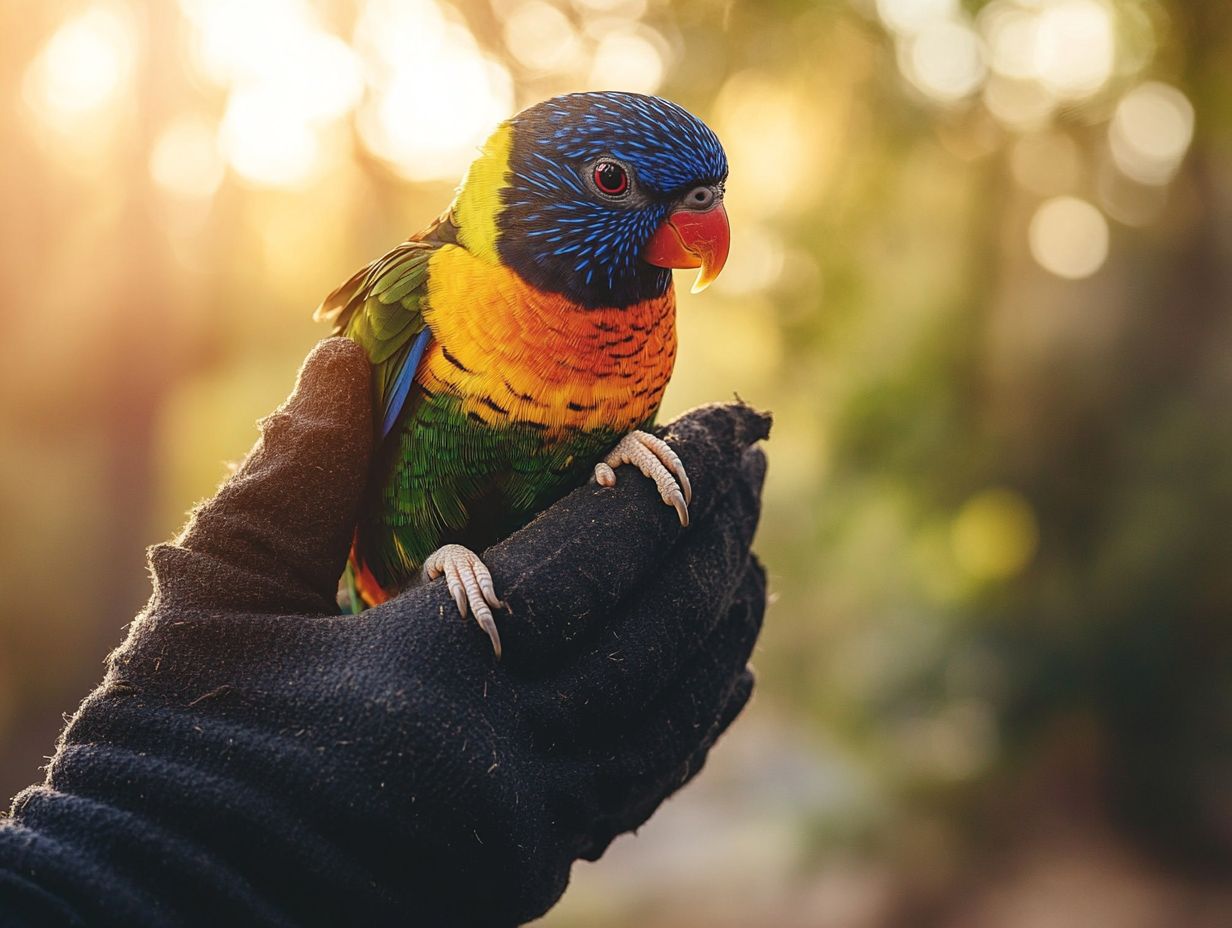
Before handling a wild bird, wear gloves and protective clothing to prevent any potential injury from the bird’s beak or claws. If you’re considering bringing birds into a home with kids, it’s also wise to learn how to safely introduce birds to children and to wash your hands before and after handling the bird to avoid transferring germs.
2. How should I approach a wild bird in order to handle it safely?
Approach the bird slowly and calmly. Avoid sudden movements that may startle it. Speak softly to signal your presence and slowly extend your hand towards the bird, allowing it to get used to you before attempting to touch it.
3. What should I do if I find a sick or injured wild bird?
If you come across a sick or injured wild bird, contact a wildlife rehabilitation center or animal control agency for assistance. They will have the knowledge and equipment to safely care for the bird.
4. Can I touch a wild bird’s nest or eggs?
No, it s best not to touch a wild bird’s nest or eggs. This can disturb the birds and may cause them to abandon their nest or eggs. If you find a fallen nest or injured bird, contact a wildlife rehabilitation center for guidance.
5. How long can I safely handle a wild bird?
Handle a wild bird for no longer than necessary, such as during an examination or if it needs immediate medical attention. The longer you handle it, the more stressed and agitated it may become.
6. Are there any potential risks to handling a wild bird?
Yes, there are risks involved in handling a wild bird. They may carry diseases or parasites harmful to humans, and their sharp claws or beaks can cause injury. Take necessary precautions and handle the bird with care to minimize these risks.
Remember, your vigilance can make a big difference for wildlife!
